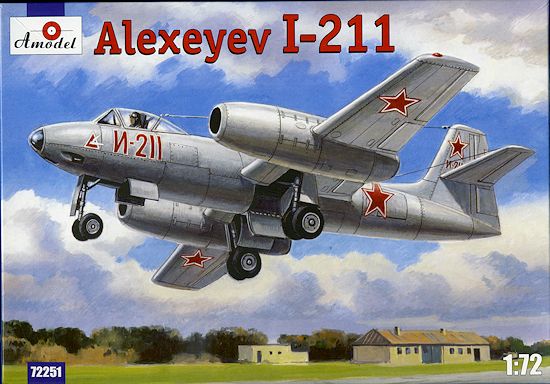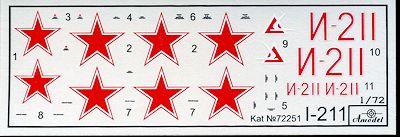
Amodel 1/72 Alekseyev I-211
| KIT #: | 72251 |
| PRICE: | $41.99 SRP |
| DECALS: | One option |
| REVIEWER: | Scott Van Aken |
| NOTES: | Short run kit |

| HISTORY |
After working as Lavochkin's right hand man during World War II, Semyon Alekseyev was appointed as Chief Designer of OKB-21 at Gor'kiy. The Council of the People's Commissars directed Alekseyev (among others) to develop jet fighters using more powerful engines than the captured German examples and their Soviet-built copies. The result of Alekseyev's efforts was the I-21 (istrebitel, fighter), which was planned to be produced in several variants.
The I-21 was a twin-engined all metal single seat jet fighter, with straight wings, mid-set on a round streamlined fuselage, and engines mounted in front of the wings at about one third span. The slightly swept tail unit was cruciform in layout with the tailplane set at approximately half-fin span with slight dihedral. The aircraft's structure was constructed from high strength B-95 aluminium alloy, high strength steel for highly loaded parts and "Elektron" magnesium alloy for cast fittings. A hydraulically retractable tricycle undercarriage was fitted, using twin wheels for nose and main undercarriages. Hydraullically actuated airbrakes were fitted either side of the rear fuselage.
Construction of the first two airframes began at the end of 1946, with extreme pressure from the Ministry of Aircraft Production to complete Initial flight testing by 1 August 1947, to enable the aircraft to take part in the Aviation Day Flypast at Tushino on 18 August 1947. While one of the two airframes initially produced was used for static testing, the other was completed as the I-211 (I-21 version 1) with Lyul'ka TR-1 turbojet engines. (The Lyul'ka TR-2 was the intended powerplant, but was not available). Despite pressure from above, the I-211 was unable to participate in the Tushino display.
Flight testing started in the Autumn of 1947, but only six test flights had been carried out before the I-211 struck a pothole on landing, which collapsed the undercarriage. Repairs were carried out and the opprtunity taken to replace the troublesome TR-1 engines with Rolls-Royce Derwent V engines. The result was the I-215 which had been in development before the first flight of the I-211. Other minor modifications were carried out, the most noticeable being the larger engine nacelles. Despite good results from flight testing the I-215 lost out in production orders to the newer generation of swept winged fighters.
A third I-21 was built as the I-215D (dooblyor, second prototype), with a bicycle undercarriage, using wider-diameter paired wheels in a bicycle arrangement, retracting into the fuselage, along with small outrigger wheels under the engine nacelles which retracted into fairings. to order from OKB-1. This was used to test this arrangement for "Aircraft 150" and other projects (OKB-1 was supervised by Dr. Brunolf Baade, who later designed the VEB type 152 airliner, in the DDR, as a direct descendent of "Aircraft 150", and indirectly of the I-215D). The main undercarriage of the I-215D also incorporated a kneeling feature which could increase the incidence of the aircraft by 3o to assist take-off. Trials with this undercarriage arrangement proved successful and paved the way for its use in many other Soviet aircraft.
Armament of the I-211 comprised two, three, four, or six cannon in the chin, depending on variant.
| THE KIT |
 The first thing I noticed was this was not the usual Amodel molding. There are no ejector towers on the inside of large parts, no sink areas, no larger than usual molding flash and in fact, quite an improvement over other kits from Amodel. Looking closer at the sprues it has 'Produced by 44 Master' stamped on it.
The first thing I noticed was this was not the usual Amodel molding. There are no ejector towers on the inside of large parts, no sink areas, no larger than usual molding flash and in fact, quite an improvement over other kits from Amodel. Looking closer at the sprues it has 'Produced by 44 Master' stamped on it.

| CONCLUSIONS |
| REFERENCES |
http://en.wikipedia.org/wiki/Alekseyev_I-211 March 2013 Thanks to me for getting this one to show you. If you would like your product reviewed fairly and fairly quickly, please contact the editor or see other details in the